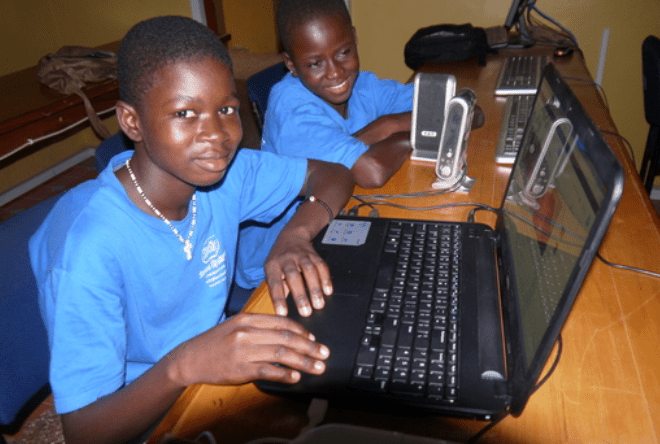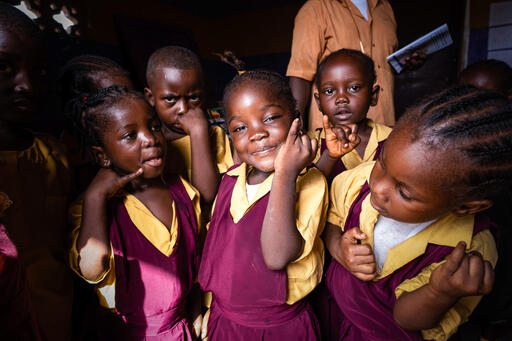Many schools around the world remain closed or experience intermittent closures due to the COVID-19 pandemic, making remote learning essential to children’s education. Governments are using a range of methods to support remote learning, including paper-based “take home” learning packages, radio, television and online platforms.
In addition to connectivity and access to devices, information communication technology (ICT) literacy skills are critical to online learning. Using new data from the UNICEF-supported Multiple Indicator Cluster Survey (MICS), and building upon a recent analysis of ICT skills among young people, this blog analyses gender gaps in ICT skills among adolescents in eight countries in sub-Saharan Africa.
A key finding: Fewer girls than boys possess ICT skills
A key finding is that in most of the countries analysed, girls face disadvantages in acquiring ICT skills, whether in school or at home. For example, Figure 1 below shows that in Ghana, 16 per cent of adolescent boys possess ICT skills compared to only 7 per cent of adolescent girls.
Adolescents who are not equipped with ICT skills will have difficulty navigating online learning platforms and are at risk of not being able to access online services as adults. It is vital that all children be equipped with ICT skills, and that the digital gender divide be closed, particularly given the importance of remote learning during the COVID-19 pandemic.
ICT skills are associated with attending school – but less so for girls
In all countries except for Sierra Leone, the prevalence of ICT skills is significantly higher among adolescents who attend school than among those who do not. In Madagascar, for example, 13 per cent of adolescents in school have ICT skills, compared to only 1 per cent of their out-of-school peers.
However, with the exception of Lesotho, the association between ICT skills and school attendance is weaker for girls than for boys (Figure 2). For instance, in The Gambia, 15 per cent of in-school adolescent boys have ICT skills compared to 2 per cent for those out-of-school (a 13 percentage point difference), while for adolescent girls the figure is 8 per cent for those in-school versus 2 per cent for those out-of-school (a 6 percentage point difference).
Moreover, the gender gap in ICT skills is wider among adolescents who attend school than among those who do not. For instance, in Ghana, there is no gender gap in ICT skills among out-of-school adolescents, while among adolescents attending school, there is more than a five-percentage point difference in ICT skills, to the detriment of girls. In Zimbabwe the gender gap is nearly three times higher among adolescents attending school than among out-of-school adolescents. The data suggest that ICT skills are facilitated by schooling, but there may be gender-related barriers that prevent adolescent girls from developing these skills to the same extent as boys.
Girls benefit less from having a computer in the home
In addition to school, the home environment can be a critical space for developing and practicing ICT skills. In all countries analysed, both adolescent girls’ and boys’ ICT skills are greater among individuals who have computers at home (Figure 3).
That said, the presence of a computer in the home doesn’t erase the digital gender divide. For example, among households with computers in the Democratic Republic of the Congo and Ghana, girls have lower levels of ICT skills than boys. And the gender gap in ICT skills is wider than among adolescents in households without computers (Figure 3).
In more than half of the countries analysed, adolescent boys use computers and the Internet more frequently than girls (Figure 4). For example, in the Democratic Republic of the Congo, 46 per cent of adolescent boys with computers at home use computers at least once a week compared to just 24 per cent of girls. Gender norms that limit girls’ use of digital technologies may contribute to this gap.
Equitable remote learning depends on addressing the digital gender divide
Ensuring connectivity and addressing supply-side issues (infrastructure, access to IT devices, teacher capacities and educational content) facilitates remote learning, but at a time when school closures have made remote learning a critical part of many children’s lives, these steps alone are not enough. The digital gender divide must also be eliminated.
Even in households where online learning is an option, there is still a high risk that girls will fall behind boys. Gender norms may prevent girls from acquiring ICT skills. Parental restrictions are among the most common barriers to digital access for children, and in many countries, concerns about girls’ online safety and the fear that girls will become exposed to content that goes against their community’s values, mean girls are discouraged from using the Internet. In addition, girls may be socialized from an early age to believe boys are naturally more suited to the ICT field, leading girls to doubt their abilities and caregivers and teachers to invest less in girls’ opportunities to develop ICT skills.
The COVID-19 crisis may pass, but the importance of ICT skills will continue to grow. In sub-Saharan Africa, many adolescent girls aren’t developing the ICT skills needed to engage in digital learning or compete in the modern labour market. It is vital that this digital gender divide be addressed at home, at school and in the wider community so that no girl is left behind.






